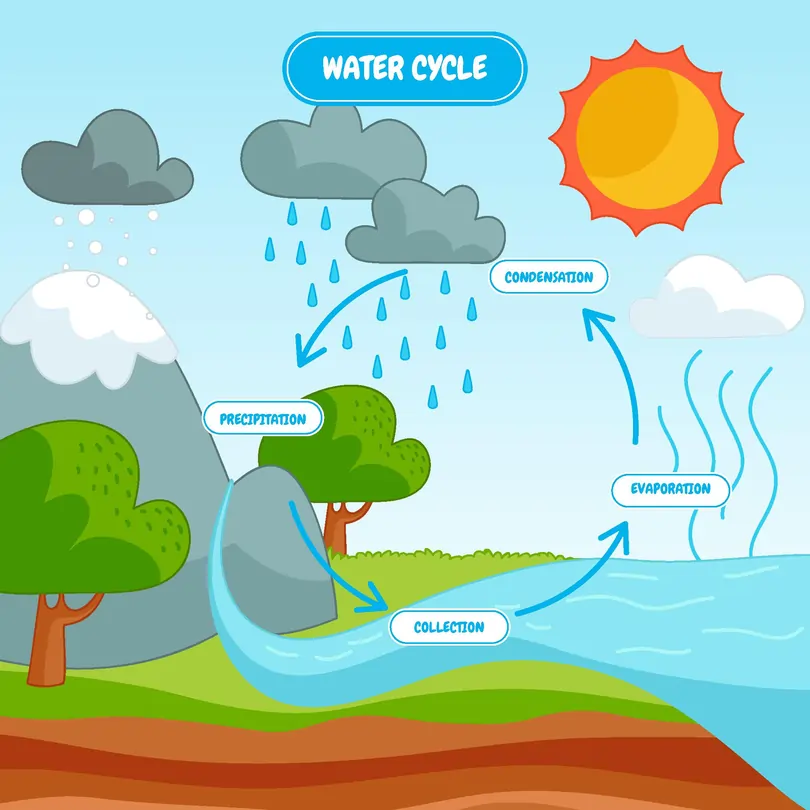The water cycle: An in-depth exploration of Earth’s hydrological process

Introduction to the Water Cycle
The water cycle, also known as the hydrological cycle, is the continuous and dynamic process that circulates water throughout Earth's atmosphere, surface, and underground reservoirs. This cycle is fundamental to sustaining life, regulating the climate, and shaping the planet's landscapes. The water cycle is not just a simple process of water movement; it is a complex system involving various physical, chemical, and biological processes that ensure water is constantly recycled and reused.
Understanding the water cycle provides insight into how water moves through different states—liquid, gas, and solid—and how it travels from one part of the Earth to another. This journey of water is crucial for the balance of ecosystems, the availability of fresh water, and the overall functioning of the Earth’s environmental systems.
The primary stages of the water cycle
The water cycle can be broken down into four primary stages that describe the movement and transformation of water:
- Evaporation: Water from the Earth's surface, primarily from oceans, lakes, and rivers, turns into water vapour and ascends into the atmosphere.
- Condensation: Water vapour in the atmosphere cools down and transforms into liquid droplets, forming clouds.
- Precipitation: When the droplets in clouds become too heavy, they fall to the Earth as rain, snow, sleet, or hail.
- Collection: The water that falls as precipitation collects in bodies of water like rivers, lakes, and oceans, as well as infiltrates the ground to replenish groundwater reserves.
These stages represent a simplified version of the water cycle, but each stage encompasses numerous processes that contribute to water's overall movement and storage.
Breaking down each stage of the water cycle
1. Evaporation
Evaporation is the process by which liquid water is transformed into water vapour, a gaseous state, and then moves into the atmosphere. This process is driven by the sun's heat, which provides the energy required for water molecules to break free from the liquid state and become vapour.
-
Mechanism of evaporation
As water absorbs heat, the molecules gain kinetic energy, eventually reaching a point where they can escape the liquid surface and enter the air as vapour. This process occurs more rapidly when temperatures are higher and when the surface area of the water body is larger.
-
Transpiration
In addition to evaporation from bodies of water, plants also contribute to water vapour in the atmosphere through a process called transpiration. During transpiration, plants absorb water through their roots and release it as vapour through tiny pores in their leaves. Combined, evaporation and transpiration are often referred to as evapotranspiration, which plays a significant role in the water cycle.
2. Condensation
Condensation occurs when water vapour in the atmosphere cools and changes back into liquid form. This process typically happens when warm, moist air rises and cools as it expands in the atmosphere.
-
Cooling process and dew point
As the air cools, it reaches a temperature called the dew point, where the air is saturated with water vapour, and condensation begins. This cooling process is essential for cloud formation, as the tiny droplets of condensed water gather around dust particles, forming clouds.
-
Formation of clouds
The tiny droplets that form during condensation cluster together around small particles like dust, salt, or smoke in the atmosphere. These particles act as nuclei, providing surfaces on which the water can condense. As these droplets merge and grow, they form the clouds that we see in the sky.
3. Precipitation
Precipitation is the process by which water, in various forms, falls from the atmosphere to the Earth’s surface. This is the primary way that water returns to the surface and is a crucial part of the water cycle.
-
Varieties of precipitation
Precipitation can occur as rain, snow, sleet, or hail, depending on the temperature and atmospheric conditions. Rain is the most common form of precipitation, but in colder climates, snow and sleet are also frequent. Hail forms during strong thunderstorms when updrafts carry raindrops high into the freezing upper atmosphere, where they accumulate layers of ice before falling to the ground.
-
The physics behind raindrop formation
Raindrops form when small droplets in clouds collide and merge. These larger droplets eventually become too heavy to remain suspended in the cloud and fall to the Earth as precipitation.
4. Collection
After precipitation, water collects in various places on Earth, continuing its journey in the water cycle.
-
Surface runoff and groundwater recharge
Some of the water that falls as precipitation flows over the land as surface runoff, eventually reaching rivers, lakes, and oceans. Other portions of the water infiltrate the soil, replenishing underground aquifers, which are critical sources of fresh water for drinking, agriculture, and industry.
-
Role of oceans, rivers, and lakes
The majority of the Earth's water is stored in the oceans, which are the main reservoirs in the water cycle. Rivers and lakes serve as intermediaries, transporting water from the land back to the oceans. This collection stage is essential as it ensures that water is available for future evaporation, continuing the cycle.
The Sun: The engine of the water cycle
The sun is the primary energy source that drives the water cycle. Without the sun's energy, the water cycle would not function, as it powers the processes of evaporation and condensation, which are critical for the movement of water through the atmosphere and back to the surface.
Solar radiation and energy transfer
The sun's energy heats the Earth’s surface, causing water to evaporate. This energy transfer also influences the temperature and pressure conditions that drive atmospheric circulation, affecting where and how clouds form and where precipitation occurs.
Seasonal variations
The intensity of the sun’s radiation changes with the seasons, leading to variations in the water cycle. For example, during the summer months, higher temperatures increase the rate of evaporation, which can lead to more precipitation, while in winter, reduced sunlight can slow down the cycle.
The water cycle’s role in climate regulation
The water cycle plays a crucial role in regulating the Earth’s climate. By distributing heat and moisture across the planet, the water cycle helps to maintain a balance in the atmosphere, influencing weather patterns and stabilising temperatures.
Heat distribution
As water evaporates, it absorbs heat from the environment, which cools the surface. When the water vapour condenses into clouds, it releases this heat back into the atmosphere, warming the surrounding air. This process helps to distribute heat across the globe, balancing temperature differences between different regions.
Atmospheric circulation
The water cycle is closely linked with atmospheric circulation patterns, such as the trade winds, jet streams, and monsoons. These patterns are driven by the differential heating of the Earth’s surface and the movement of water vapour, which influences weather systems and precipitation patterns around the world.
water cycle is closely linked with atmospheric circulation patterns, such as the trade winds, jet streams, and monsoons. These patterns are driven by the differential heating of the Earth’s surface and the movement of water vapour, which influences weather systems and precipitation patterns around the world.
Anthropogenic influences on the water cycle
Human activities have increasingly influenced the natural water cycle, leading to changes in how water moves and is distributed across the planet.
- Pollution: Industrial waste, agricultural runoff, and sewage discharge can introduce harmful pollutants into water bodies, affecting the quality of water that enters the water cycle. Polluted water can disrupt ecosystems, harm wildlife, and pose risks to human health.
- Urbanisation: The expansion of cities and infrastructure has altered natural water flows. Paved surfaces prevent water from infiltrating the ground, increasing surface runoff and the risk of flooding. Urbanisation also often leads to the destruction of natural habitats, further impacting the water cycle.
- Climate Change: Rising global temperatures are accelerating the rate of evaporation, altering precipitation patterns, and increasing the frequency of extreme weather events such as droughts and floods. These changes disrupt the water cycle, leading to shifts in water availability and quality.


 SG
SG  VN
VN 


















